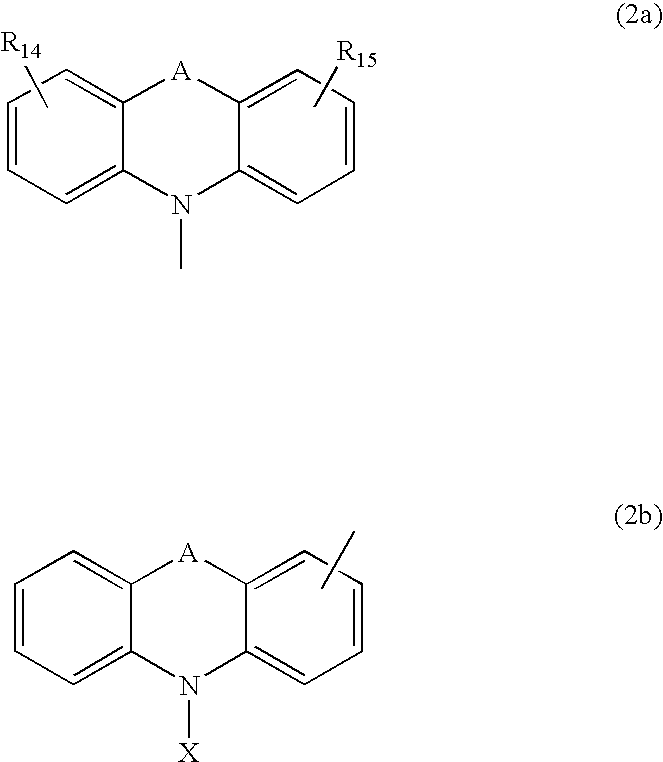Material for organic electroluminescent device and organic electroluminescent device using same
a technology of electroluminescent devices and materials, which is applied in the direction of discharge tube luminescnet screens, natural mineral layered products, etc., can solve the problems of short circuit or pixel defects, and achieve excellent heat resistance, long life, and high luminous efficiency.
- Summary
- Abstract
- Description
- Claims
- Application Information
AI Technical Summary
Benefits of technology
Problems solved by technology
Method used
Image
Examples
synthesis example 1
[Synthesis of Compound (A-7′)]
[0172]
(1) Synthesis of Intermediate (IM-1)
[0173] 25.4 g (90 mmol) of 4-bromoiodobenzene, 10.0 g (60 mmol) of carbazole, 0.1 g (0.5 mmol) of copper iodide, and 26.7 g (126 mmol) of potassium phosphate were suspended into 70 ml of 1,4-dioxane. Then, 0.7 ml (6 mmol) of trans-1,2-cyclohexanediamine was added to the suspension, and the whole was refluxed and heated in an argon atmosphere for 14 hours.
[0174] After the temperature of the reaction solution had been cooled to room temperature, methylene chloride and water were added to the solution to separate the solution into two layers. After that, an organic layer was sequentially washed with a 5% aqueous solution of hydrochloric acid and water, and was then dried with anhydrous sodium sulfate.
[0175] An organic solvent was distilled off under reduced pressure. After that, 50 ml of ethanol were added to the resultant, and the precipitated crystal was filtered and sequentially washed with ethanol and norma...
synthesis example 2
[Synthesis of Compound (A-16′)]
[0188]
[0189] 5.0 g (16.3 mmol) of 2,2′-dibromobiphenyl, 10.1 g (35.3 mmol) of Intermediate (IM-1), 740 mg (0.64 mmol) of tetrakistriphenylphosphinepalladium (0), 150 ml of dimethoxyethane (DME), and an aqueous solution of sodium carbonate [prepared by dissolving 10.2 g (96 mmol) of sodium carbonate into 120 ml of water] were loaded into a 500-ml flask under an argon atmosphere, and the whole was stirred at 78° C. for 15 hours.
[0190] After that, the temperature of the resultant was cooled to room temperature, and the precipitated crystal was filtered out.
[0191] The precipitated crystal was sequentially washed with water, methanol, and hexane, and was then recrystallized three times by using toluene. Thus, 6.9 g (10.8 mmol, 68% yield) of Compound (A-16′) were obtained. A measurement of the FD-MS is shown below.
[0192] FD-MS: calcd for C48H32N2=636, found, m / z=636 (100).
[0193] In addition, the result of HPLC (column: ODS-3V, mobile phase: acetonitrile / ...
synthesis example 3
[Synthesis of Compound (B-3′)]
[0195]
(1) Synthesis of Intermediate (IM-2)
[0196] 70 g (0.22 mol) of 1,3,5-tribromobenzene, 73.6 g (0.44 mol) of carbazole, 4.2 g (22 mmol) of copper iodide, 187 g (0.88 mol) of potassium phosphate, 25 g (0.22 mol) of trans-1,2-cyclohexanediamine, and 700 ml of 1,4-dioxane were loaded into a 2-liter three-necked flask under an argon atmosphere, and the whole was stirred at 104° C. for 16 hours.
[0197] After that, the temperature of the resultant was cooled to room temperature, 600 ml of water were added to the resultant, and the whole was extracted with methylene chloride. After that, an organic layer was washed with water, dried with anhydrous magnesium sulfate, filtered out, and concentrated under reduced pressure until it was brought into a slurry state.
[0198] The resultant solid was filtered, and the filtrate was additionally concentrated under reduced pressure.
[0199] The residue was dissolved into 300 ml of toluene, and the whole was purified wi...
PUM
| Property | Measurement | Unit |
|---|---|---|
| glass transition temperature | aaaaa | aaaaa |
| work function | aaaaa | aaaaa |
| thickness | aaaaa | aaaaa |
Abstract
Description
Claims
Application Information
 Login to View More
Login to View More - R&D
- Intellectual Property
- Life Sciences
- Materials
- Tech Scout
- Unparalleled Data Quality
- Higher Quality Content
- 60% Fewer Hallucinations
Browse by: Latest US Patents, China's latest patents, Technical Efficacy Thesaurus, Application Domain, Technology Topic, Popular Technical Reports.
© 2025 PatSnap. All rights reserved.Legal|Privacy policy|Modern Slavery Act Transparency Statement|Sitemap|About US| Contact US: help@patsnap.com



